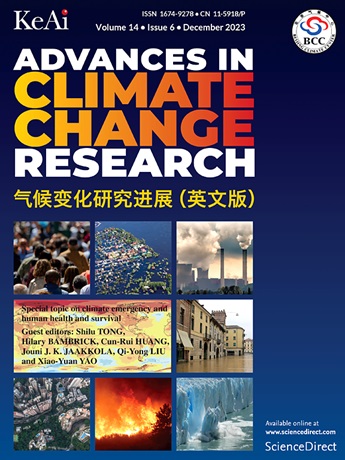结合CMIP6预估和基于卫星的检索,开发未来每月地表太阳辐射的高分辨率数据集
IF 5.2
1区 地球科学
Q1 ENVIRONMENTAL SCIENCES
引用次数: 0
摘要
对未来太阳表面辐射(SSR)的准确预估对于评估气候变化的影响和太阳能潜力具有重要意义。然而,来自耦合模式比对项目第6阶段(CMIP6)的气候模式在SSR预估中表现出显著的不确定性。本研究利用贝叶斯线性回归(BLR)方法综合CMIP6模式预估和卫星反演数据,建立了1850-2100年的高质量月度SSR数据集。根据CMIP6模型在SSR模拟中的历史表现,选择了5个CMIP6模型。BLR方法根据历史模拟与卫星SSR产品(称为ISCCP-ITP-CNN)在1983-2014年期间的匹配程度为每个模型分配网格权重。计算加权多模型集合,生成一个综合的长期SSR数据集。基于历史时期(1960—2017年)地面观测数据的评估表明,综合SSR优于单个CMIP6模型及其原始多模型平均值,在月尺度上RMSE从32 ~ 36 W/m2减小到25 W/m2,偏差从5 ~ 13 W/m2减小到- 1 W/m2。空间格局与iscp - itp - cnn(1983-2018)吻合较好。高分辨率(0.1°× 0.1°)合成的SSR数据集提供了1850-2100年间历史实验和四种未来共享社会经济路径(SSP)情景(SSP126、SSP245、SSP370和SSP585)的月度预测,代表了未来SSR变化及其相关的气候影响。该数据集有望增强对未来各种气候情景下陆地表面过程和太阳能应用的模拟。本文章由计算机程序翻译,如有差异,请以英文原文为准。
Development of a high-resolution dataset of future monthly surface solar radiation by combining CMIP6 projections and satellite-based retrievals
Accurate projections of future surface solar radiation (SSR) are important for assessing the impacts of climate change and the potential of solar energy. However, climate models from the Coupled Model Intercomparison Project Phase 6 (CMIP6) exhibit notable uncertainties in SSR projections. This study aims to develop a high quality monthly SSR dataset during 1850–2100 by synthesizing CMIP6 model projections and satellite-derived retrievals using a Bayesian Linear Regression (BLR) method. Five CMIP6 models are selected based on their historical performance in simulating SSR. The BLR method assigns gridded weights to each model based on how well the historical simulations matched the satellite-based SSR product (called ISCCP‒ITP‒CNN) over the period 1983–2014. The weighted multi-model ensemble is calculated to generate a synthesized long-term SSR dataset. Evaluation against ground-based observations during historical periods (1960–2017) shows that the synthesized SSR outperforms individual CMIP6 models and their original multi-model mean, with a reduced RMSE from 32 to 36 W/m2 to 25 W/m2 and a bias from 5 to 13 W/m2 to −1 W/m2 on monthly scales. The spatial patterns also agree well with the ISCCP‒ITP‒CNN (1983–2018). The high-resolution (0.1° × 0.1°) synthesized SSR dataset provides monthly projections over historical experiments and four future shared socio-economic pathway (SSP) scenarios (SSP126, SSP245, SSP370, and SSP585) during 1850–2100, representing future SSR changes and associated climate impacts. The dataset is expected to enhance simulations of land surface processes and solar energy applications under a variety of future climate scenarios.
求助全文
通过发布文献求助,成功后即可免费获取论文全文。
去求助
来源期刊

Advances in Climate Change Research
Earth and Planetary Sciences-Atmospheric Science
CiteScore
9.80
自引率
4.10%
发文量
424
审稿时长
107 days
期刊介绍:
Advances in Climate Change Research publishes scientific research and analyses on climate change and the interactions of climate change with society. This journal encompasses basic science and economic, social, and policy research, including studies on mitigation and adaptation to climate change.
Advances in Climate Change Research attempts to promote research in climate change and provide an impetus for the application of research achievements in numerous aspects, such as socioeconomic sustainable development, responses to the adaptation and mitigation of climate change, diplomatic negotiations of climate and environment policies, and the protection and exploitation of natural resources.
 求助内容:
求助内容: 应助结果提醒方式:
应助结果提醒方式:


